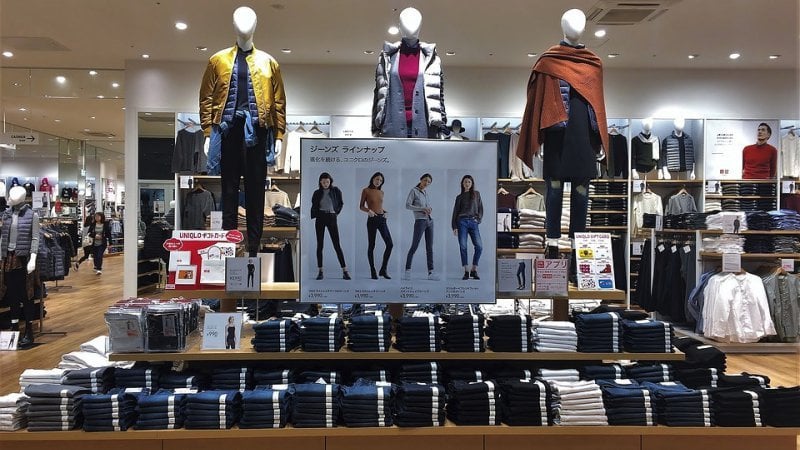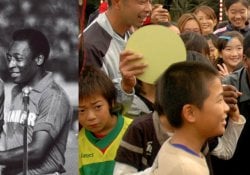In this article we are going to talk about clothes and accessories in Japanese. Don't think we're just going to memorize words. Japanese grammar can get a little tricky when it comes to wearing clothes.
Índice de Conteúdo
clothing size in japan
Before we talk about the Japanese language, let's quickly remind you that Japan has its own clothing size standard. I will not delve into this subject, but I will leave a small table to help.
The conversion table below is usually the standard for Japanese clothing.
T-Shirt Conversion Table
| Size | Bust | Waist | Height | European | Estados Unidos |
|---|---|---|---|---|---|
| S | 82 to 90 | 72 to 80 | 158 to 165 | 36 | 14 |
| M | 87 to 95 | 79 to 87 | 158 to 165 | 38 | 15 |
| L | 92 to 100 | 86 to 94 | 175 to 185 | 40 | 16 |
The following table is more accurate when it comes to women's clothing, but it also follows a unisex pattern:
| Size in Letter | Japanese number | bust (cm) | Waist (cm) | Hips (cm) |
| SS/XS | 3 | 75 to 78 | 58 to 62 | 81 to 84 |
| S | 5 | 78 to 81 | 62 to 66 | 85 to 88 |
| S | 7 | 82 to 85 | 67 to 69 | 89 to 92 |
| M | 9 | 86 to 88 | 70 to 72 | 92 to 96 |
| L | 11 | 89 to 92 | 72 to 76 | 96 to 100 |
| LL/XL | 13 | 92 to 96 | 77 to 80 | 100 to 104 |
| LLL/XXL | 15 | 96 to 102 | 77 to 80 | 100 to 104 |
| 4L/3X | 17 | 103 to 106 | 89 to 93 | 109 to 113 |
| 5L/4X | 19 | 106 to 109 | 93 to 97 | 114 to 118 |
| 6L/4X | 2 | 110 to 115 | 98 to 101 | 119 to 123 |
Remembering that we already have an article talking about the japanese breasts and bra sizes.
clothing and accessories vocabulary in japanese
| Portuguese | Japanese | Romaji |
| clothes | 衣服 | ifuku |
| clothing | 衣料品 | iryouhin |
| kimono | 着物 | kimono |
| swimwear/summer | 浴衣 | Strawhatz - Kimono |
| obi | 帯 | obi |
| (wooden) clogs | 下駄 | geta |
| glasses | 眼鏡 | megane |
| coat | コート | koto |
| about everything | オーバー | ōbā |
| Tuxedo | スーツ | sūtsu |
| walking suit | 背広 | tallow |
| raincoat | レインコート | reincarnation |
| jacket / winter clothes | 上着 | uwagi |
| underwear | 下着 | shitagi |
| underwear / panties / underwear | パンツ | pantsu |
| bra | ブラジャー | burajā |
| Swimsuit | 水着 | mizugi |
| jacket | ジャケット | jaketto |
| pajamas | パジャマ | pajamas |
| sport jacket | ブレザー | burezā |
| shirt | ブラウス | burausu |
| dress | ドレス | painu |
| one piece dress | ワンピース | wanpi-su |
| pants | ズボン | zubon |
| short pants | 半ズボン | hanzubon |
| Bermuda | ショーツ | sho-tsu |
| pants | スラックス | surakkusu |
| jeans | ジーンズ | jīnzu |
| get out | スカート | sukāto |
| shirt | シャツ | shatsu |
| T-shirt | t-shirt | t-shatsu |
| White shirt | ワイシャツ | washatsu |
| sweater | セーター | arrow |
| cardigan | カーディガン | kādigan |
| sweat shirt (coach) | トレーナー | torēnā |
| hat Cap | 帽子 | boushi |
| earring | イヤリング | iyaringu |
| earrings / piercing | ピアス | piasu |
| necklace | ネックレス | nekkuresu |
| necktie | ネクタイ | nekutai |
| tissue | スカーフ | sukāfu |
| ring | 指輪 | yubiwa |
| belt | ベルト | beruto |
| shoes | 靴 | kutsu |
| socks | 靴下 | kutsushite |
| sneakers | スニーカー | sunīkā |
| flip-flops | スリッパ | surippa |
| sandals | サンダル | sandaru |
| high-heeled shoes | ハイヒール | haihīru |
| boots | ブーツ | būtsu |
Wearing clothes in Japanese - Verb
In Japanese, there is not only the expression "I am dressing a shirt". The Japanese language is more specific when describing actions. So, there are several ways to tell you're wearing something.
Present Progressive / Continuous
There are 3 main ways to say you are wearing something in Japanese. The 3 ways are:
| Romaji | Kana / Kanji | used in clothes |
| Kite | 着て | Above the Waist |
| Haiti | 履いて | Below the Waist |
| Kabutte | かぶって | In the head |
The 3 verbs mentioned above are in the Present Progressive which is used for an ongoing action, ongoing action and state of being. It is also used to express the same meaning as the English present perfect or present continuous.

Simple Present / Indicative mood
| Romaji (Informal / Formal) | Kana / Kanji | Use |
| Kiru / Kimasu | 着る / 着ます | Above the Waist |
| Haku / Hakimasu | 履く/ 履きます | Below the Waist |
| Kaburimasu | かぶります | In the head |
The simple present is also used to refer to someone who is wearing something, but expresses routine, everyday facts, etc. Like, he "wears" is "using" wearing "his"...
The indicative mood is for common, objective statements of fact. The present tense is used for incomplete habitual actions as well as for future intentions.

The article is still halfway through, but we recommend also reading:
Other Verbs for Clothing
In addition to the 3 main ways to dress in Japanese, there are other verbs used for specific situations or accessories. Below is a list of words:
| Meaning | Japanese | Romaji |
| wear hat | 帽子をかぶる | Boushi wo kaburu |
| Use glasses | めがねをかけ | Megane wo kakeru |
| wear earrings | イヤリングをつける | Iyaringu wo tsukeru |
| wear tie | ネクタイを締 める | Nekutai wo shimeru |
| use scarf | スカーフを巻く | Sukaafu wo Maku |
| wear gloves | 手袋をはめる | Tebukuro wo hameru |
| wear rings | 指輪をはめる | Yubiwa wo hameru. |
| wear watches | 時計をする | Tokei wo suru. |
| wear shirt | シャツを着る | Shatsu wo kiru. |
| wear pants | ズボンをはく | Zubon wo haku |
| wear shoes | 靴を履く | Kutsu wo haku |
- Kaburu - is used to put on the head;
- Kakeru - also means "to hang";
- Tsukeru - also means, "attach";
- Shimeru - also means: "to tie";
- Maku - also means "to wrap around";
- Hameru - also means: "insert";
- Kiru - is used to put on the body;
- Haku - is used to put on the legs;
phrases about clothes in japanese
- 彼は帽子をかぶっています
- Kare wa boshi or kabutte imasu
- He's wearing (putting on) a hat
- 私はシャツを着ています
- Watashi wa shatsu or kite imasu
- I am wearing a shirt
- 彼女はズボンを履いていません
- Kanojo wa zubon o haite imasen
- She is not wearing pants
- 彼女はいつもこざっぱりした服を着ている。
- Kanojo wa itsumo kozappari shita fuku or kite iru;
- She is always well dressed (well groomed.)
- 彼女はグリーンのドレスを着ていた。
- Kanojo wa gurīn no dorsu o kiteita;
- She wore a green dress;
- 今日はスーツを着ています
- Kyō wa sūtsu or kite imasu
- Today I'm wearing a suit
- 私は帽子をかぶります
- Watashi wa boshi or kaburimasu
- i am wearing a hat
- この着物を着ませんか。
- Kono kimono or kimasen ka
- You don't wear this kimono?
- 休日に着る手頃な着物を今選んでいるところです。
- Kyūjitsu ni kiru tegorona kimono o ima erande iru tokorodesu;
- Now, I'm choosing suitable clothes to wear during the holidays;
- 雨が降ったり雪が降ったりすると、私はいつもブーツを履きます。
- Ame ga futtari yuki ga futtari suru to, watashi wa itsumo būtsu o hakimasu;
- I always wear boots when it rains or snows;
- その少年は運動靴を履くと、外へ走って出て行った。
- Sono shōnen wa undō kutsuwohaku to, Soto e hashitte deteitta;
- The boy put on the sneakers. and ran out;







